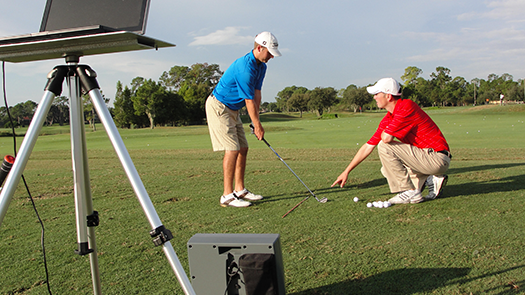The old ideal was for every teacher to learn club fitting and take care of their students’ gear needs. It turns out there’s a range of fitting solutions.
When the first fitting carts appeared on lesson tees 30 years ago, the companies that provided them preached that club fitting was the province of the teaching professional. Instructors were told that the club purchase should be a transaction between a teacher and his or her student, based on the precision-fitting methodology. From that point forward, it’s been up to instructors to decide whether to embrace this idea fully or find other ways to address the equipment needs of their students.
There’s quite a variance among top instructors as to how much or how little club fitting they do. On the enthusiastic end of that spectrum is Cathy MacPherson, a noted professional based in Middleton, Mass. These days she’s got two methods of handling the equipment needs of her students—fit them herself or use the services of Club Champion, as 400-plus of her fellow professionals also do.
MacPherson has kept hands-on club fitting in her repertoire even as she’s benefitted from the Club Champion arrangement that began two years ago. Over that time, she’s had dozens of students go through a Club Champion fitting and purchase clubs. She considers the program a win-win. “Their business model is impressive, and we’ve had a great flow of communication,” says MacPherson. “I’ve gotten to know their fitters, and we talk about how to do what’s best for each golfer. That’s been a key element to success.”
At the larger academies, a job description of a specialist in golf gear has emerged. An example is the Mike Bender Golf Academy in Lake Mary, Fla., where Matt Wilkes is one such expert—although Wilkes does teach his roster of students along with running junior clinics and coaching groups of women players.
Despite how advanced his golf-equipment skills have become, Wilkes still sees the world through the eyes of a teacher. No matter how inappropriate a client’s clubs maybe, Wilkes will still “point them to instruction” if their baseline ability to make a swing that advances the ball is below a certain level. And yes, his nationally known colleagues Cheryl Anderson and Mike Bender do assign to Wilkes the step-by-step of a club fitting session needed by one of their students, albeit with substantial consultation based on their swing diagnosis.
There will always be full-time instructors—and you may be one of them—who have a talent for fitting clubs, enjoy doing it, and connect teaching with fitting in an organic way. One such coach is Bill Abrams, director of instruction at Golf Solutions Academy in Crete, Ill. For Abrams, there are multiple reasons to keep the gear aspect of golf performance under his aegis. Generally speaking, it enhances continuity in the teacher-student relationship, he argues quite convincingly.
“We give students whatever we can to help them improve, whether that’s swing technique, a fitness regimen, better course management—and those things tie back to equipment,” says Abrams. “A student can build their core and their upper body, and at that point, the clubs may need another look. With the juniors, especially the boys of a certain age, I might switch them through two or three shafts a year.”
The cost of shaft changes of this type is no significant factor, either. Abrams sources UST shafts at a discount, he uses PGA Trade-in services liberally, and he’s “built a library of fitting shafts over the years that gives me a lot of options.” Shaft couplings that allow instant switch-out, no epoxy needed, also facilitate Bill’s approach. Even set configuration can be affected by what gets taught. As strategic thinking improves, a golfer may decide they need a couple of new hybrids that offer a better chance to play from optimal positions.
Meanwhile, the fitting has an artistic side, in which the golfer sees and feels results that are naturally pleasing to the eye. “The trajectory of the shot, the curve, the full flight, the hang time—all those things matter to golfers,” Abrams says. The gear side of Bill’s annual revenue comes to between 15 and 20 percent, he says. And that’s not counting the loyalty factor among lesson-takers that his skill and ingenuity as a fitter help build.
If you’ve set a goal to run your teaching business more effectively in 2020, CLICK HERE to learn about Instructor Plus, a new service that’s helping coaches solve business problems and succeed as never before.


